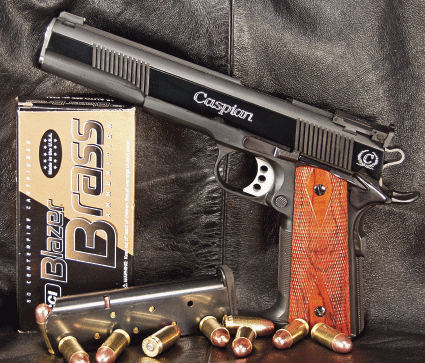It isn’t often that I get to shoot a $4,200 pistol. That’s probably for the best, other people’s high-dollar 1911s make me nervous. Here at the “Prisbrey Magazine Article Factory,” I make every effort to return loaner guns in decent shape. But, occasionally, things sorta happen, and a minor scratch or two may go back along with a particular sample. Bad enough on a $600 revolver or a $900 auto, but I really get the willies when we pass the $2,000 mark.
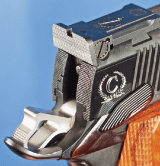 It started with an e-mail one day advising that Bill Laughridge of C&S would be sending me a custom 1911 for review, and I innocently said, “Okie dokie.” I was horrified to see the thing when it arrived, and immediately sat down on a carpeted floor with nothing that could damage the finish inside a five-foot circle around me while I looked it over. It later traveled to the gravel pit for its shooting session in an extremely well-padded case. My own guns are another matter entirely, and I expect them to acquire signs of wear and honest use, but if I could have unrolled a section of carpet on the dirt and pebbles under my traveling shooting table, just in case, I would have.
It started with an e-mail one day advising that Bill Laughridge of C&S would be sending me a custom 1911 for review, and I innocently said, “Okie dokie.” I was horrified to see the thing when it arrived, and immediately sat down on a carpeted floor with nothing that could damage the finish inside a five-foot circle around me while I looked it over. It later traveled to the gravel pit for its shooting session in an extremely well-padded case. My own guns are another matter entirely, and I expect them to acquire signs of wear and honest use, but if I could have unrolled a section of carpet on the dirt and pebbles under my traveling shooting table, just in case, I would have.
Bill runs a very versatile shop, and they can do just about anything you’d want on your own handgun. C&S has several “packages” in the form of standardized services at fixed prices so you can choose one and know what you’re getting into just by looking at their website, but their true versatility lies in their ability to let you decide what you want on your gun when you send it to them for a makeover. Going a step further, C&S can also provide a complete custom pistol. What we’re looking at here is one of those.
Advertisement — Continue Reading Below
Gun Details
It’s a long name to go with a long pistol, but the Super Grade Long Slide is just that. Built on a Caspian Race Ready frame and using a Caspian long slide to mate with the 6-inch BarSto stainless match target barrel, this is truly a Super Grade pistol in terms of materials, fitting and workmanship. You could spend more on gold plating, rubies and emeralds, but while it may get more expensive, it doesn’t get any better. And, the price tag is easy to understand when you handle this pistol.
Check out these Dream Guns: 6 of the Most Expensive Guns on the Market
In terms of finish, the Super Grade gets the Master Polish done on the slide flats, ambidextrous safety, slide stop, grip screw heads, mainspring housing pin, plunger tube, and magazine button. The result is a deep and glossy blue with no polish “ripples” in the slide flats. The rear of the extractor has been perfectly mated to the rear of the slide, and both the slide rear and speedbump on the high upswept beavertail safety are checkered at 40 lpi (lines per inch). Frontstrap and mainspring housing are also checkered, here at 20 lpi. The top of the slide stop lever is fully checkered, slide cocking serrations both fore and aft were cleaned up, and the frame and longitudinally grooved slide top are matte beadblasted. Inside, all internal working surfaces were polished and de-burred.
Advertisement — Continue Reading Below
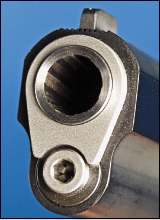 In fitting, the slide was hand fitted to the frame, the mainspring housing was mated to the oversized integral funneled magazine well, the frame was machined for installation of the ramped barrel, the barrel was throated at the rear and 11-degree beveled at the crown, Caspian adjustable rear and dovetailed front sight was installed, with a gold bead added to the front sight blade, oversized firing pin stop fitted, plunger tube and grip screw bushings staked to the frame, and Spegel High Grade double-diamond checkered cocobolo grips added. The barrel and slide locking lugs were very clean with nary a rattle in the slide nor any play in pushing down on the chamber area of the barrel through the lowered and scalloped ejection port.
In fitting, the slide was hand fitted to the frame, the mainspring housing was mated to the oversized integral funneled magazine well, the frame was machined for installation of the ramped barrel, the barrel was throated at the rear and 11-degree beveled at the crown, Caspian adjustable rear and dovetailed front sight was installed, with a gold bead added to the front sight blade, oversized firing pin stop fitted, plunger tube and grip screw bushings staked to the frame, and Spegel High Grade double-diamond checkered cocobolo grips added. The barrel and slide locking lugs were very clean with nary a rattle in the slide nor any play in pushing down on the chamber area of the barrel through the lowered and scalloped ejection port.
Besides the BarSto barrel and stainless National Match bushing, other components were also top tier, with C&S long aluminum ventilated and serrated trigger that’s adjustable for overtravel, wide high-grip ambi safety, extended ejector, tuned and radiused CNC extractor, five-piece Ultra Match Trigger Pull Set (skeletonized stainless hammer, sear, disconnector, three-leaf flat spring and coil mainspring), and tactical match hammer strut. The 18.5-pound recoil spring, standard magazine catch spring, extra power firing pin spring, and plunger spring all came from Wolff, and the pistol shipped with two C&S Extreme Duty split-follower blued magazines with relatively thin Pachmayr checkered rubber bumper pads that fit nearly flush with the bottom of the magazine well. In addition, Ed Brown’s two-piece 6-inch recoil spring guide rod and grip safety finish up the picture. What’s it all mean? Let’s look a little closer.
First off, no, you certainly do not need all this extra work to have a functional 1911 pistol. You also don’t need a Mercedes to get to work, but everyday in this great country somebody buys one to go places a Toyota will drive to just as well. The key’s in the trip, not the destination. A Mercedes will have a nicer factory stereo system, more comfortable seats, and a smoother ride. Same principle here. You buy a high-dollar pistol built with better components and more hand fitting, and you’ll simply enjoy the trip a little more than you might with a base 1911 in factory form.
Advertisement — Continue Reading Below
Starting on the frame, checkering anchors the grip area in your hand under recoil and in just about any environmental condition short of dunking the pistol in a bucket of warm butter. No matter how you shoot, one-handed, two-handed, three-handed, weak-handed, strong-handed, isosceles, Weaver, off a rest, around a barricade, or over the hood of a pickup truck, the pistol stays put, period! Checkering, in general and when done correctly, is our friend. Cutting it on the rear of the slide breaks up glare around the rear of the sight area in some lighting conditions, and that can be a benefit since better sighting frequently equals better shooting. Ditto on the horizontal striations at the rear of the sight blade itself.
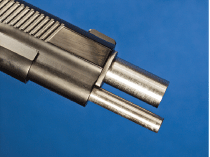 Speaking of sights, do we need adjustables on what John Browning designed as a pure fighting tool? Depends on what you intend for the tool to do. For close-up defensive work with standard 230-grain ball or hollowpoints in a concealed carry pistol, no, we don’t. For some target uses, “Run & Gun” sports, bowling pin matches, and even hunting applications where concealment isn’t an issue and ammo variability is, adjustable sights are very handy. I have C&S gold beads on my own guns, and this one stands out quite visibly against the big, all-black rear blade in its square U notch. If you want to run anything from 185s on up through 200s to 230s, you dial the load in with your screwdriver and let the pistol do the work. No guessing, no Alabama Overunderage, and no compensating in trying to make one sight setting put all sorts and kinds of different loads into the same spot on each shot.
Speaking of sights, do we need adjustables on what John Browning designed as a pure fighting tool? Depends on what you intend for the tool to do. For close-up defensive work with standard 230-grain ball or hollowpoints in a concealed carry pistol, no, we don’t. For some target uses, “Run & Gun” sports, bowling pin matches, and even hunting applications where concealment isn’t an issue and ammo variability is, adjustable sights are very handy. I have C&S gold beads on my own guns, and this one stands out quite visibly against the big, all-black rear blade in its square U notch. If you want to run anything from 185s on up through 200s to 230s, you dial the load in with your screwdriver and let the pistol do the work. No guessing, no Alabama Overunderage, and no compensating in trying to make one sight setting put all sorts and kinds of different loads into the same spot on each shot.
BarSto barrel? Your great-grandpappy did just fine in the trenches without a match barrel back in The Big War. But he was playing a different kind of ballgame there. The reason that premium match 1911 barrels by makers like BarSto are used in high-end custom guns isn’t because a regular old run-of-the-mill factory barrel is bad, it’s simply that a top-grade match barrel is better. A factory barrel is manufactured to certain general tolerances to fit other general tolerances specified elsewhere in a given pistol. The theory is that if all parts are kept within their ranges, most will assemble themselves together with a minimum of expensive hand fitting. And that works decently well, most of the time.
Advertisement — Continue Reading Below
But, in a true custom pistol, hand fitting is maximized because it gives better results in performance at the end of the job. A BarSto barrel is typically held to a more consistent and tighter tolerance level in its internal chamber dimensions, as well as being oversized on the outside in areas such as the locking lugs. The tighter chamber positively influences accuracy, and so does a barrel that’s correctly mated with the locking lugs of the slide, a tight barrel bushing up front, and the feet under the chamber where the link rides.
Consistency is the goal, and with little or no slop in how the barrel relates to its neighbors, parts-wise, each shot fired can be more consistent as the gun cycles. The original 1911 design uses an internal section of the frame just forward of the top of the magazine as the feedramp. During feeding, that means a bullet nose hits the frame running, then diverts up into the rear of the chamber. Many serious 1911 users have their barrels throated for more reliable feeding, and the BarSto barrel takes that a step further by incorporating its own integral feedramp, here mirror polished by C&S. Worth the extra money? If mere incidentals like accuracy and reliability mean anything to you, they are.
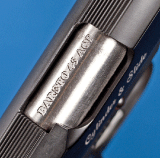 I don’t use a flared magazine well on my carry 1911s, but competition shooters like them, and in a pistol that’s perfectly suitable for games like this one is, it fits right in. I even found myself liking the forward sweep of the frame at the bottom. Not as much room to pinch out a stuck magazine in this magazine well, but loads of help guiding one in, and being a permanent part of the cast frame, it’ll never work loose.
I don’t use a flared magazine well on my carry 1911s, but competition shooters like them, and in a pistol that’s perfectly suitable for games like this one is, it fits right in. I even found myself liking the forward sweep of the frame at the bottom. Not as much room to pinch out a stuck magazine in this magazine well, but loads of help guiding one in, and being a permanent part of the cast frame, it’ll never work loose.
Advertisement — Continue Reading Below
Safeties can be an individual preference and shooting styles vary, but it takes something of a masochist to keep on with a 1911 in original form with GI-type hammer, grip safety, and thumb safety. I understand there are actually people who enjoy that kind of abuse, but nobody I know admits to being one of them. A good beavertail grip safety is money well spent in eliminating hammer bite and controlling the pistol under recoil. Ambidextrous safeties are somewhat controversial; most people who say they’re not needed don’t shoot their 1911s left-handed. For those who do shoot with the “wrong” hand, or think they might have to someday for whatever reason, an ambidextrous thumb safety has its merits. A downside to the double-sided safety is a tendency during carry with some holsters for the outboard lever to get itself knocked off-safe. Here, carry isn’t as much of a concern (use a properly fitting holster if it is), and the Swenson-based design of this safety with a strong connection between the two halves and right lever captured under the grip panel makes it a non-worry. The combination of the two safeties and grip configuration adds up to a very comfortable shooting hold if you use a thumbs-up position like I do. And that’s just not something you can say about a bare-bones factory 1911.
Bill’s crew at C&S likes the Caspian frames and slides for scratch-built custom projects. The tolerances are excellent, and very consistent, for large parts that are carefully and precisely mated, not just assembled, to each other. There was no play anywhere between the slide and frame on the test pistol. Frames are produced for Caspian by the Ruger Pine Tree Investment Casting Facility, and if you have a prejudice against cast frames, you might want to note two things. First, not all are equal, and the Caspians are at the top of the pyramid in quality. Secondly, the company’s frames and bar stock slides are widely used by custom makers, and believe me, Ruger Pine Tree knows how to cast large parts!
We’ve been skirting around the basic concept itself, the 6-inch barrel. Why would you want one? If the 1911 was meant to have a 6-inch tube and slide, wouldn’t John Browning have designed it that way to begin with? Well, as we’ve seen over the years, the basic platform can be modified in a number of directions, and nothing in the Official Rulebook Of Handgunnery says it can only be shortened. The additional length was fairly popular among certain sportsgunners some time back, before the advent of competition pistols, because it makes an easy-shooting .45ACP. You get the extra weight out front to reduce muzzle jump, a lessened recoil impulse, slightly higher velocities, and a longer sight radius. Coupled with the BarSto barrel and hand fitting of the C&S Super Grade Long Slide in general, the result is a markedly different 1911 than you’re probably used to shooting.
Advertisement — Continue Reading Below
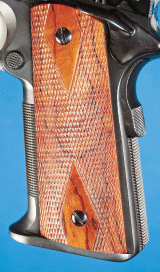 Range Time
Range Time
Considering this configuration to be more of a competition and recreational pistol than a carry gun, I took four standard 230-grain hardball loads, one 185-grain truncated metal jacket load, and one 185-grain full metal jacket semi-wadcutter match target load to the gravel pit with it.
At the usual 25 yards from a rest, the 6-inch pistol was quite accurate compared to other 1911s I’ve worked with, including a couple of others that were also high-dollar customs. The days of me breaking under an inch at that distance with any pistol are pretty much behind me, but I was satisfied with what it did in my hands. As expected, the Federal Gold Medal Match 185-grain semi-wads were good performers, with a best five-shot group at 1.5 inches, and even the practice-grade brass-cased CCI Blazer 230-grain hardball pulled off a best of 1.75 inches. In the right hands with the right eyeballs, it’d do better.
The amount of steel and wood checkering on this pistol doesn’t let it wander in the shooting grip, and it fit very well with either a high or low thumb hold. On unaltered 1911s there’s always something that digs into either the base of my shooting thumb, or the inside of the thumb as it rests on the thumb safety. No problems on the Long Slide. Muzzle rise and recoil were easily controllable, and the sights were very visible. In fact, one function of those horizontal striations on the rear sight blade if the sun’s behind it is to brightly light up the entire blade, without any distracting glare, and the gold dot is easy to drop into the notch. Not a single malfunction with any of the full-metal jacketed rounds in round ball, truncated flatnose, or semi-wadcutter form. The hugely funneled magazine well makes for a slick reload, with plenty of room between the forward flare at the bottom and the triggerguard for even large hands, and I liked the overall heft of the pistol.
Advertisement — Continue Reading Below
After the formal target session, I was settling into the fun part when disaster struck. Shooting a highly structured regimen at targets of opportunity (aka plinking) with a coffee can of miscellaneous .45ACP leftovers, the Long Slide showed a tendency to not feed hollowpoints reliably. Any ball ammo, including some old and shorter-than-normal light lead handloads, fed perfectly. On the third magazine of mixed loads, in trying to analyze the feeding glitch, the barrel link sheared off about in the center of its bottom hole. That apparently also took out the extractor hook, and ended the session before I had a chance to try the second magazine included to determine if the hollowpoint problem was magazine related.
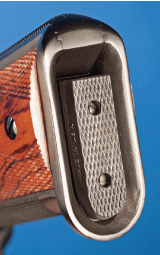 I can now also say, besides the fact that I don’t often get to shoot a $4,200 pistol, I also don’t often get to break a $4,200 pistol.
I can now also say, besides the fact that I don’t often get to shoot a $4,200 pistol, I also don’t often get to break a $4,200 pistol.
Does that mean it’s all over for this custom pistol? Nope. This obviously should not have happened, but even brand new magazines do go bad, and the link could be either a matter of a defective small part failure (which happens occasionally regardless of maker or source), or a very slightly misfitted barrel. Normally, the link isn’t considered a highly stressed part, its only real function is to pull the barrel down during cycling. But, if the barrel is not precisely fitted at the rear it can stress that link beyond its normal limits and a failure can result. Either way, it’s aggravating, but C&S will correct any problems that may turn up on subsequent pistols. Other deadlines didn’t allow enough time to return this sample and re-shoot it after repairs, but I have no doubts about C&S’ ability to address its issues.
Advertisement — Continue Reading Below
Final Notes
Altogether it’s an interesting pistol, and if you’re a dyed-in-the-wool-1911 shooter, you may want to give the concept a try. I’m already considering a Long Slide for a project next year in a more carry-friendly field grade version, and C&S will build one to just about any level you want, for fun, work or play. Get with them at www.cylinder-slide.com to discuss details and pricing on your custom long-barreled pistol.
